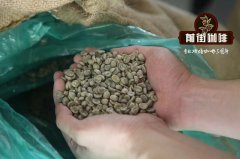Katim Coffee characteristics _ Katim Coffee beans English Catimor_ Katim Coffee Price of half jin

Professional coffee knowledge exchange more coffee bean information please follow the coffee workshop (Wechat official account cafe_style)
In order to make use of Luodou's robust and high-yielding genes, Arabica seeds were crossed with Robusta coffee seeds, and some natural hybrid varieties were selected to cultivate excellent ones for planting. Then backcross hybrids for many generations to try to cultivate a delicious and sturdy variety of coffee.
In the world's major commercial coffee producing areas, farmers have grown a large number of these hybrid coffee containing Luodou gene, after all, high yield and disease resistance are directly related to the livelihood of coffee farmers. Moreover, when exporting, it is often mixed together and will not be specially separated and marked. Importers are more concerned about the origin, and quality standards such as size, hardness, defect rate and so on.
The more famous hybrid bean is the Katim Coffee Bean (Catimor), a 1/4 Rhodo pedigree, derived from a cross between Kaddura (Arabica) and Timor (the original sound of Timor), a natural hybrid found in East Timor.
On the Indonesian island of Sumatra, Ateng (Katim's native name) and Tim Tim- are Timor (half of the Luodou gene) already account for 70% of exports. The so-called Manning is actually a three-in-one of these two kinds of hybrid beans and iron pickup (one of the Arabica species).
Colombia also grows a large number of its own Katim coffee beans (it is said that it has been backcrossed for many generations, and the gene of Luodou has been greatly reduced). It is named "Colombia" after the country, which shows the degree of importance and has become one of the major export varieties.
The local Roa hybrid in Kenya, called Ruiru 11, is also likely to replace the traditional variety SL28/34 in the export of commercial beans.
China's Yunnan, exports to Starbucks, Nestl é and other major international coffee manufacturers are basically Katim species, after all, high yield, disease resistance, high economic benefits to coffee farmers.
Catimor, a hybrid of timor and caturra, was developed in 1959 by the Portuguese Coffee Leaf Rust Research Center (CIFC). Its research direction is disease resistance and high yield.
Catimor has high yield, short plant, dense planting and red-brown new leaves.
The robusta gene inherited from timor makes catimor more resistant to coffee berry disease, coffee leaf rust and insect pests, but it is often criticized for its performance in the cup.
Catimor fruit ripens quickly and has high yield, which requires adequate fertilizer supply and shading. In addition, the high yield of catimor corresponds to a relatively shorter commercial life, with an average of only ten years.
When growing at low altitude, the cup performance of catimor has no obvious advantages and disadvantages compared with other commercial varieties. When planted above 1200 meters above sea level, the flavor of catimor cup is obviously inferior to that of bourbon, caturra and catuai.
Catimor was first developed in 1959 and was popularized in Brazil in the 1970s and 1980s. With disease resistance and high yield, it occupies a place in Central and South American coffee varieties. The occasional outbreak of coffee leaf rust crisis in Central and South America has also contributed to the application of catimor.
Coffee varieties based on catimor Katim Coffee can be found in major coffee producing countries, such as Colombia, Indonesia, and--
Yunnan, China
Qianjie coffee: Guangzhou bakery, the store is small but a variety of beans, you can find a variety of unknown beans, but also provide online store services. Https://shop104210103.taobao.com
Important Notice :
前街咖啡 FrontStreet Coffee has moved to new addredd:
FrontStreet Coffee Address: 315,Donghua East Road,GuangZhou
Tel:020 38364473
- Prev

Current situation of coffee cultivation in Yunnan _ how much is half a jin of Katim coffee _ where can I get coffee beans in Guangdong
Professional coffee knowledge exchange more coffee bean information please follow the coffee workshop (Wechat official account cafe_style) Yunnan coffee cultivation status 1. Yunnan mainly grows small coffee beans, which is what we often call Arabica coffee beans. Among them, Katim coffee bean variety has been developed in Yunnan because of its strong anti-virus ability, high yield, considerable economic value and good quality.
- Next

Panamanian Hardman Coffee Red Wine treatment how to drink Panamanian coffee?
Professional coffee knowledge exchange more coffee bean information please follow the coffee workshop (Wechat official account cafe_style) in recent years held the annual international cup test competition and bidding for the best coffee in Panama Best of Panama and Panamanian Emerald Manor (Hacienda La Esmeralda) has completely changed, this bid attracted global attention in addition to the attraction of coffee itself, when
Related
- Detailed explanation of Jadeite planting Land in Panamanian Jadeite Manor introduction to the grading system of Jadeite competitive bidding, Red bid, Green bid and Rose Summer
- Story of Coffee planting in Brenka region of Costa Rica Stonehenge Manor anaerobic heavy honey treatment of flavor mouth
- What's on the barrel of Blue Mountain Coffee beans?
- Can American coffee also pull flowers? How to use hot American style to pull out a good-looking pattern?
- Can you make a cold extract with coffee beans? What is the right proportion for cold-extracted coffee formula?
- Indonesian PWN Gold Mandrine Coffee Origin Features Flavor How to Chong? Mandolin coffee is American.
- A brief introduction to the flavor characteristics of Brazilian yellow bourbon coffee beans
- What is the effect of different water quality on the flavor of cold-extracted coffee? What kind of water is best for brewing coffee?
- Why do you think of Rose Summer whenever you mention Panamanian coffee?
- Introduction to the characteristics of authentic blue mountain coffee bean producing areas? What is the CIB Coffee Authority in Jamaica?

